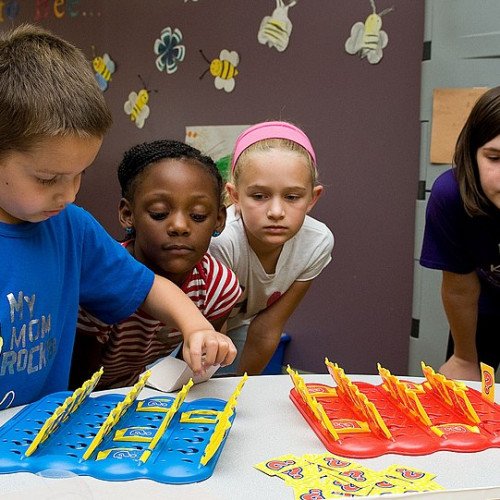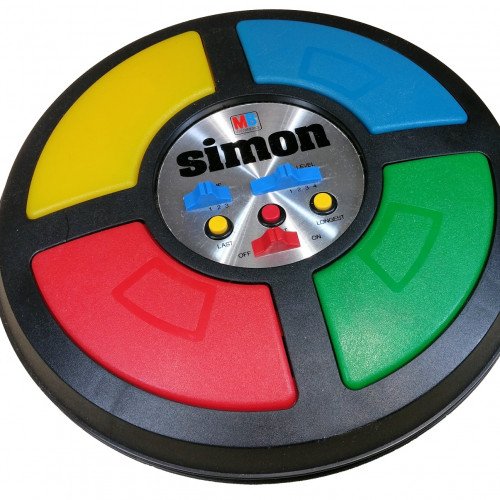GUESS WHO VS SIMON

GUESS WHO
Guess Who? is a two-player character guessing game created by Ora and Theo Coster, also known as Theora Design, that was first manufactured by Milton Bradley in 1979 and is now owned by Hasbro. It was first brought to the UK by Jack Barr Sr. in 1982. The classic edition is currently being produced by Winning Moves Games USA. Each player starts the game with a board that includes cartoon images of 24 people and their first names with all the images standing up. Each player selects a card of their choice from a separate pile of cards containing the same 24 images. The objective of the game is to be the first to determine which card one's opponent has selected. Players alternate asking various yes or no questions to eliminate candidates, such as: "Does your person wear a hat?" "Does your person wear glasses?" "Is your person a man?" The player will then eliminate candidates (based on the opponent's response) by flipping those images down until only one is left. Well-crafted questions allow players to eliminate one or more possible cards. Special editions which have different faces have been released, including Star Wars, Marvel Comics and Disney. There are smaller, "travel" editions which have only 20 different faces. In 2008 and 2010, extra and mix and match games were released. A computer game based on the series was released in 1999 by Hasbro Interactive. In the United States, advertisements for the board game often showed the characters on the cards coming to life, and making witty comments to each other. This caused later editions of such ads to carry the spoken disclaimer line "game cards do not actually talk" in order to meet Federal Trade Commission advertising guidelines requiring full disclosure of toy features unable to be replicated with the actual product.
Statistics for this Xoptio

SIMON
Simon is an electronic game of memory skill invented by Ralph H. Baer and Howard J. Morrison, working for toy design firm Marvin Glass and Associates, with software programming by Lenny Cope. The device creates a series of tones and lights and requires a user to repeat the sequence. If the user succeeds, the series becomes progressively longer and more complex. Once the user fails or the time limit runs out, the game is over. The original version was manufactured and distributed by Milton Bradley and later by Hasbro after it took over Milton Bradley. Much of the assembly language code was written by Charles Kapps, who taught computer science at Temple University and also wrote one of the first books on the theory of computer programming. Simon was launched in 1978 at Studio 54 in New York City and was an immediate success, becoming a pop culture symbol of the 1970s and 1980s. Ralph H. Baer and Howard J. Morrison were introduced to Atari's arcade game Touch Me at the Music Operators of America (MOA) trade show in 1976. Baer said of the product, "Nice gameplay. Terrible execution. Visually boring. Miserable, rasping sounds." The prototype built by Baer used the low cost Texas Instruments TMS 1000 microcontroller chip, which was in many games of the 1970s. Lenny Cope, who was one of Ralph H. Baer's partners, programmed the core of the game, titled Follow Me at the time. Baer developed the tones of the game, inspired by the notes of a bugle. When they pitched the demo, an 8-by-8-inch console, to the Milton Bradley Company the name of the game was changed to Simon. Simon debuted in 1978 at a retail price of $24.95 (equivalent to $98 in 2019) and became one of the top-selling toys that Christmas. U.S. Patent 4,207,087: "Microcomputer controlled game", was granted in 1980. Milton Bradley soon capitalized on the original with both the smaller-sized Pocket Simon and the expanded, eight-button Super Simon. Many variants of Simon have been made since Hasbro acquired Milton Bradley in the 1980s, building on the possibilities offered by advances in technology. The original Super Simon was reinvented in the late 1990s as a hexagonal unit with six buttons. 2000 saw Simon Squared (or Simon2), a unit with the four traditional buttons on one side, and a set of eight smaller buttons on the other. In 2004, Hasbro released the Simon Stix. The game features two electronic sticks (modeled after drumsticks), an emphasis on the musical part of the game, and features four levels of play. In 2005, Hasbro released Simon Trickster (also known as Simon Tricks in Europe and in the UK, and as Simon Genius in Brazil), which features four game modes, in a similar fashion to another Hasbro game, Bop It, and colored lenses instead of buttons. "Simon Classic" mode plays up to 35 tones(notes). "Simon Bounce" is similar to "Simon Classic", but instead the colors of the lenses change. "Simon Surprise" is one of the most difficult games in the unit. Every lens becomes the same color and the player has to memorize the location. "Simon Rewind" requires the player to memorize the sequence backwards. During each game, the player is paid a compliment after a certain number of tones completed. On reaching five and eleven tones, the computer will randomly choose "Awesome!", "Nice!", "Sweet!" or "Respect!". On reaching 18 tones, the game will play a victory melody three times. On reaching the ultimate 35 tones, the game will play the victory melody again and will say "Respect!". If the player fails to memorize the pattern or fails to press the right color within the time limit, the game will play a crashing sound and the game will say "Later!".